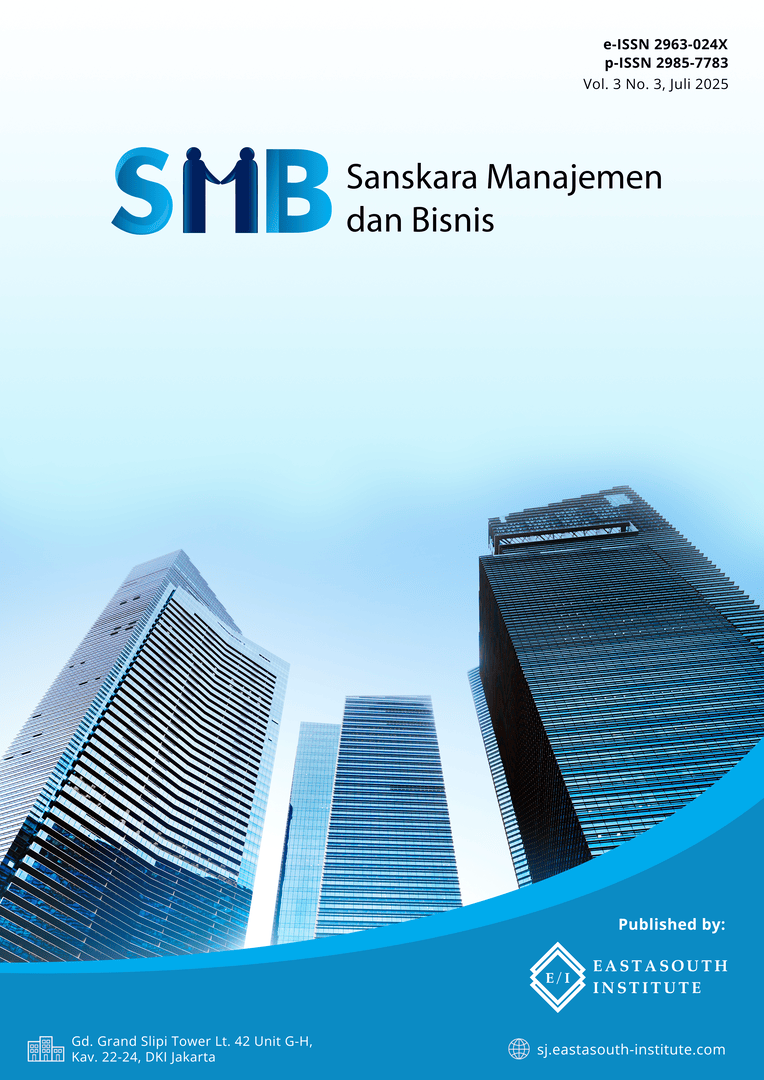Pengaruh Strategi Blue Ocean Berkelanjutan terhadap Keunggulan Bersaing dan Inovasi Perusahaan di Indonesia
Main Article Content
Abstract
Penelitian ini mengkaji pengaruh Strategi Laut Biru Berkelanjutan (SBOS) terhadap keunggulan kompetitif dan inovasi di perusahaan-perusahaan Indonesia. Seiring dengan meningkatnya persaingan dan pasar yang semakin jenuh, perusahaan-perusahaan semakin beralih ke kerangka strategis yang menekankan diferensiasi dan keberlanjutan. Dengan pendekatan kuantitatif, data dikumpulkan dari 120 responden di berbagai sektor bisnis di Indonesia melalui kuesioner terstruktur menggunakan skala Likert 5 poin. Data dianalisis menggunakan SPSS versi 25. Hasil penelitian menunjukkan bahwa SBOS memiliki pengaruh positif dan signifikan terhadap keunggulan kompetitif dan inovasi. Perusahaan yang menerapkan SBOS lebih cenderung unggul dibandingkan pesaing dan mendorong praktik inovatif dengan menciptakan ruang pasar yang tidak terkontestasi sambil mengintegrasikan nilai-nilai lingkungan dan sosial. Temuan ini menyoroti pentingnya SBOS sebagai strategi strategis bagi perusahaan di pasar emerging yang mengincar keberlanjutan dan pertumbuhan jangka panjang.
Article Details

This work is licensed under a Creative Commons Attribution-ShareAlike 4.0 International License.
References
Aryanti, J., & Kaltum, U. (2023). Analisis Strategi Persaingan PT Kalbe Farma Tbk.
Braun-Thürmann, H. (2005). Innovation. transcript Verlag.
Camisón-Zornoza, C., & Boronat-Navarro, M. (2011). Product Innovation as a Result of Knowledge Development Processes in Organisations. In Knowledge Management for Process, Organizational and Marketing Innovation: Tools and Methods (pp. 134–147). IGI Global Scientific Publishing.
Fowler, S. J., & Hope, C. (2007). Incorporating sustainable business practices into company strategy. Business Strategy and the Environment, 16(1), 26–38.
Ghajiga, G. S., Warlimont, D. J., & Warlimont, P. S. (2023). Leap-Frogging the Competition through Blue Ocean Strategy: A Compelling Case For Small and Medium Enterprises. Ovidius University Annals, Economic Sciences Series, 23(1), 113–121.
Gómez, J. M., Roca, S. T., & Álvarez, L. M. G. (2023). Innovación en las organizaciones: Una revisión de la literatura. Dictamen Libre, 32, 73–87.
Hambali, A. (2024). Komitmen atas SDGs-9, Tingkat Inovasi, dan Dampaknya Pada Kinerja Keberlanjutan Perusahaan. Jurnal Akuntansi, 53–68.
Ibrahim, F. (2023). Innovative Strategy for Sustainable Business Model Development with Value and Social Impact Approach for Economic Sustainability. Journal of Contemporary Administration and Management (ADMAN), 1(3), 285–292.
Jaime, A., & Costas, M. (2006). Strategic Innovation at the Base of the Economic Pyramid. Harvard Business Online.
Kenyon, G. N., Sen, K. C., Kenyon, G. N., & Sen, K. C. (2015). Creating a competitive advantage. The Perception of Quality: Mapping Product and Service Quality to Consumer Perceptions, 5–12.
KRUGLIKOVA, V. (n.d.). Theoretical Aspects Of Enterprise Competitiveness Formation. Підприємництво Та Управління Розвитком Соціально-Економічних Систем Entrepreneurship And Management Of The Development Of Socio-Economic Systems, 143.
Leavy, B. (2018). Value innovation and how to successfully incubate “blue ocean” initiatives. Strategy & Leadership, 46(3), 10–20.
Leković, B., & Marić, S. (2016). Innovativeness as a source of competitive advantage for entrepreneurial ventures and small business. Strategic Management-International Journal of Strategic Management and Decision Support Systems in Strategic Management, 21(3).
Liça, D., & Gashi, S. (n.d.). The Relationship between Innovation and Competitive Advantage: A Literature Review. Index of Authors, 59.
Lubnina, A. A., Misbakhova, C. A., Arestova, E. N., Isaychev, V., Pavlikov, S., Kozin, M., & Alenina, E. (2017). Innovative strategy for increasing competitiveness in organizational structures of industrial enterprises. Eurasian Journal of Analytical Chemistry, 12(7b), 1563.
Maksum, A., Munawarah, Sitepu, Y. L. B., & Kumalasari, F. (2024). Sustainability, Risk Management, and Innovation: Enhancing Performance in Indonesian Social Enterprises. Journal of Risk and Financial Management, 17(12), 561.
Mebert, A., & Lowe, S. (2017). An Analysis of W. Chan Kim and Renée Mauborgne’s Blue Ocean Strategy: How to Create Uncontested Market Space. Macat Library.
Murni, T. (2017). The Effect of Entrepreneurial Orientation to Low Cost Strategy, Differentiation Strategy, Sustainable Innovation and Performance of Small and Medium Enterprises (Studies at Batik Small and Medium Enterprises in East Java Province, Indonesia). European Journal of Business and Management, 9(20), 137–153.
Onoigboria, M., Johnny, E., & Nwagbala, S. C. (2025). Blue Ocean Strategy and Competitive Performance of Selected Aluminum Extrusion Firms in South-South and South-East Nigeria. International Journal of Accounting and Public Sector Management, 2(2), 1–17.
Putri, A., & Nasution, M. I. P. (2025). 10 PENDAPAT AHLI MENGENAI KEUNGGULAN KOMPETITIF. JOURNAL SAINS STUDENT RESEARCH, 3(1), 98–104.
Rajasekaran, R. (2016). Blue Oceans in Indian Sesame Oil Industry: A Case Analysis. IUP Journal of Business Strategy, 13(2).
Sahani, T. (2025). Charting New Horizons: Innovation Meets Sustainability in Business. Journal of Next-Generation Research 5.0.
Seran, M. D. A. R. L., Hwihanus, H., & Lavenia, L. (2024). Urgency of Corporate Social Responsibility (CSR) for Corporate Advancement in Indonesia. Jurnal Sains Sosio Humaniora, 8(1).
Strategy, B. O. (2015). Blue Ocean Strategy. Marketing, 1009, 4C.
W Chan, K. (2006). Blue ocean strategy.
Zekiri, J., & Nedelea, A. (2012). Strategies for achieving competitive advantage. The USV Annals of Economics and Public Administration, 11(2), 63–73.

